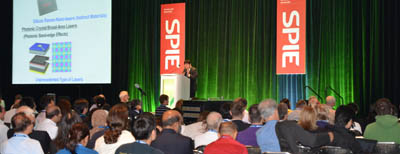Annual event includes larger-than-ever nanotechnology program

Seventeen plenary talks are among highlights on the program at SPIE Optics + Photonics; above, Susumu Noda of Kyoto University speaks at the 2013 event.
BELLINGHAM, Washington, USA -- Plenary talks on the future of wearable optics, fusion energy, and the search for habitable worlds in space will highlight opening-day technical sessions at SPIE Optics + Photonics 2014. The event runs 17-21 August, in San Diego, California, USA, and is sponsored by SPIE, the international society for optics and photonics.
Symposium-wide plenary speakers on opening day will include:
Fourteen more plenary presentations throughout the week will include talks on nanoscale engineering, photovoltaic technology, image processing, organic bio-devices, and optical imaging.
The event's three-day, free-admission exhibition is the largest international, multidisciplinary optical sciences and technology event in North America.
Approximately 180 suppliers will present products and technology solutions for optical engineering, optical fabrication and design, detectors, sensors, cameras, lasers, signal imaging and processing, fiber optics, optoelectronics, LEDs and OLEDs, and test, measurement, and analysis equipment.
"This conference is critical for getting the core people together," said Petrie Yam (KLA-Tencor). "The exchange of technology really helps us to innovate new technologies and that's what we need with all these emerging markets."
A professional development program includes 32 courses and workshops on important concepts in optical and systems engineering, optomechanics, manufacturing, remote sensing, metrology, and more.
Technical attendees will have access to 3,100 papers covered by four symposia: NanoScience + Engineering, Solar Energy + Technology, Organic Photonics + Electronics, and Optical Engineering + Applications.
The NanoScience + Engineering symposium, launched in 2007, is one of the world's largest and most active nano meetings. "Optics and photonics are at the heart of nano applications ranging from cancer therapy to self-cleaning windows," said symposium co-chair David Andrews (University of East Anglia Norwich). Andrews said this year's symposium will cover a wider-than-ever range than ever of cutting-edge research and development.
Several conferences within the Optical Engineering + Applications symposium will augment technical sessions with historical and business aspects of the field.
A two-day conference will celebrate the 50th anniversary of the Optical Sciences Center, founded by Aden Meinel in 1964 and now known as the College of Optical Sciences, at University of Arizona. SPIE Fellow James Wyant, who became the founding dean when the center became a college in 2005, will give a keynote presentation.
In Photonic Innovations and Solutions for Complex Environments and Systems, Akhlesh Lakhtakia and Judith Todd (Pennsylvania State University) will moderate a panel discussion on issues such as how research agendas are being set in light of government policies and actions, and whether universities and research institutes have the right frameworks to partner with industry and government.
 SPIE will preview International Year of Light 2015 (IYL2015) festivities with a "First Light" presentation at the symposium welcome reception. Throughout the week, a booth will offer information on how to become involved in the initiative, and activities such as the SPIE International Year of Light Photo Contest. SPIE is a founding sponsor of IYL2015.
SPIE will preview International Year of Light 2015 (IYL2015) festivities with a "First Light" presentation at the symposium welcome reception. Throughout the week, a booth will offer information on how to become involved in the initiative, and activities such as the SPIE International Year of Light Photo Contest. SPIE is a founding sponsor of IYL2015.
At the SPIE Women in Optics presentation and reception, Ana María Cetto (Instituto de Física, Universidad Nacional Autónoma de México) will describe the establishment in 1996 in Mexico City of a Museum of Light. Cetto, who was on the team of optics and photonics leaders who proposed the IYL2015 to the United Nations and UNESCO, will also discuss the initiative.
An SPIE Student Chapter Leadership Workshop on 16 August will offer sessions on effective career and chapter development practices along with presentations on career skills, optics entrepreneurship, and publishing.
Conference proceedings papers will be published individually in the SPIE Digital Library as soon as approved after the meeting, and also in collected print and digital volumes.
SPIE is the international society for optics and photonics, a not-for-profit organization founded in 1955 to advance light-based technologies. The Society serves nearly 256,000 constituents from approximately 155 countries, offering conferences, continuing education, books, journals, and a digital library in support of interdisciplinary information exchange, professional networking, and patent precedent. SPIE provided more than $3.2 million in support of education and outreach programs in 2013.
###
Contact:
Amy Nelson
Public Relations Manager
amy@spie.org
+1 360 685 5478
@SPIEtweets